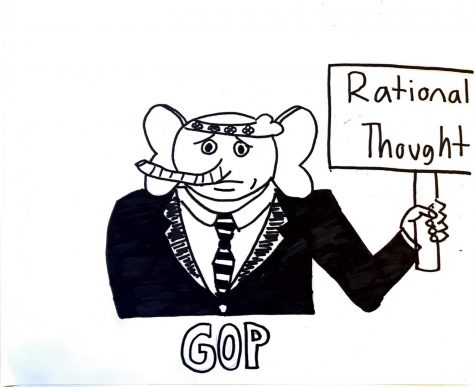The radical transformation of America’s culture and institutions: how the Right became the rebels
October 29, 2020
 In 1968, William F. Buckley and Gore Vidal, two intellectual titans with vastly different political agendas, participated in a series of debates at the Democratic Convention in Chicago. Buckley represented the new conservative movement, an insurgent cause that aimed to end the reign of New Deal liberalism in favor of a kind of libertarianism centered around traditional values. Vidal represented the even newer radical Left, which was just beginning to gain prominence in the country through anti-war demonstrations and a fierce counterculture. Their debate was one of the first intersections of two promising factions in American politics.
In 1968, William F. Buckley and Gore Vidal, two intellectual titans with vastly different political agendas, participated in a series of debates at the Democratic Convention in Chicago. Buckley represented the new conservative movement, an insurgent cause that aimed to end the reign of New Deal liberalism in favor of a kind of libertarianism centered around traditional values. Vidal represented the even newer radical Left, which was just beginning to gain prominence in the country through anti-war demonstrations and a fierce counterculture. Their debate was one of the first intersections of two promising factions in American politics.
While both groups eventually found success in their respective parties, only progressive leftists managed to take hold of America outside of its political and religious institutions. The position of conservatives and progressives has undergone a massive shift since then, resulting in their drastically different positions in the country. Using both a pre-existing base in Hollywood and universities and asserting itself in newer mediums, progressives have formed an effective cultural and institutional coalition. Since Buckley and Vidal’s 1968 debate, the two parties have completely reversed their roles in society as the left has developed a surprisingly firm hold over American music, film, academia and the tech world. Those on the Right have become the rebels, forming their own counterculture.
The presence of increasingly progressive currents is strongest in America’s universities. According to a 2015 study from the Higher Education Research Institute at UCLA, the percentage of college students who “indicated a very good chance” of participating in student demonstrations has almost doubled (4.5 percent to 8.5 percent) since 1968. Liberals dominate these institutions. According to Pew Research, the percentage of Americans with postgraduate experience who consider themselves Democrats has increased from 30 to 38 percent since 1994. In contrast, the percentage of Americans with postgraduate experience who consider themselves Republican has decreased by 11 percent from 31 to 20 percent.
While most universities have tended to lean left in the past, in recent decades they have become not only more liberal, but also strongly anti-conservative. A 2020 survey conducted by the University of North Carolina at Chapel Hill (UNC) found that 82.8 percent of conservative students heard a disparaging comment about conservatives in the past semester, but only 11.9 percent heard a disparaging comment about liberals in the same time frame.
While the left uses academic discussion to disseminate their ever-evolving principles and ideas amongst academics, platforms like Hollywood and social media increase the left’s power to influence not only the educated youth, but also anyone who interacts with modern society. More diverse ideas in these mediums would lead to more creativity, something that is essential for Hollywood, whose radical political obsessions indicate a lack of actual content.
Functioning as the hub of modern entertainment, Hollywood has become naturally more progressive ever since the end of the Red Scare, before which conservative sentiments governed the film world. In recent years, however, it has displayed unusually radical sentiments through the supposed activism of its stars and last year’s miserably repentant Oscars. The prevailing fashion during the ceremony was a shallow criticism of the lack of representation among nominations (thank god for the newly required diversity protocols!). Audiences aren’t blind to these progressive trends–even before the 2019 disaster, 22 percent more Democrats said they planned on watching the 2018 Oscars than Republicans. Hollywood’s ultra-progressivism only serves to further polarize America by making even the movies political.
While policies vary across different platforms, youth-centric social media certainly tends to the left. While right-wing extremist groups like Proud Boys have been banned from Twitter, similarly violent Antifa groups remain ontouched. “ANTIFA Philadelphia” has retained its 19.6 thousand followers. Twitter’s presence as a major social media organization gives it real power to influence American politics. According to a Forbes article by Rachel Sandler, Mark Zuckerberg, who has generally strayed away from censorship with Facebook, criticized Twitter for assuming an unreasonable role as “the arbiter of truth.”
The conservatives’ reaction to their clearly diminishing power and presence in the country has often been imprecise and angry, further worsening American morale. The class-based, geopolitical aspect of the reaction features angry blue collar workers who most blatantly expressed themselves by propelling Donald Trump into the White House. Trump’s arrival as the savior of the not only ignored, but also the insulted uneducated South fully displayed the tragedy of America’s polarization as conservatives attempted to use Trump as a vehicle to regain political power.
In a 2015 Town Hall column, economist Thomas Sowell summarized the situation well. Sowell writes, “What is … remarkable is that, after six years of repeated disasters both domestically and internationally under a glib egomaniac in the White House, so many potential voters are turning to another glib egomaniac to be his successor.”
Of course, not all voters are completely partisan; the choice between an uncharismatic Hillary Clinton and an unprofessional Donald Trump led many to vote for a candidate whom they did not like, but felt was better than the alternative. This unfortunate situation is being repeated with the 2020 election between Joe Biden and the now incumbent Donald Trump.
The other aspect of the conservative reaction is ongoing and utilizes quieter, less drastic methods. Largely dependent on the internet in order to break through the unwritten blacklist present in the mainstream, the “intellectual dark web” is an internet group that derives its intellectual unity from a belief in formerly bipartisan values, such as free speech and traditional gender biology. Its members extend across the political spectrum, from the ultra-conservative Ben Shapiro to the enthusiastically atheist Sam Harris. Although the “intellectual dark web” is not a conservative movement, its efforts against 21st century progressivism aid conservatives in their fight to regain cultural relevance.
Shapiro, a leader of the “intellectual dark web” known for his sharp debate skills, uses his conservative news site The Daily Wire to appeal to an audience of resentful conservatives. Operating outside of the mainstream allows Shapiro to use unusual tactics to gain viewers, specifically younger ones, a key audience typically missing from the conservative demographic. He publishes videos with provocative and rather immature titles, which usually include something about “owning leftists,” and often emphasize his motto “facts don’t care about your feelings.”
In a 2019 interview with The Economist, Shapiro explained, “If I can use the methodologies of gaining eyeballs to get people to look into deeper content, then I’m going to do that.” Considering the massive challenges Shapiro and other alternative-media conservatives face, crude sensationalism really is their best option.
The fact that American society has become continuously more progressive since its founding suggests that the dominant 21st century progressivism that conservatives face is only natural and is not a cause for concern. However, a look past broader trends and deep into the actual doctrine of the new progressives reveals that the “liberal” thinking of today’s progressives actually runs counter to the fundamental philosophy of past liberal thought, which regarded human reason as the supreme authority and favored freedom over absolute equality. We are currently experiencing the advent of “postmodernism,” a leftist movement defined by its reluctance to accept facts and to live within the bounds of logical thinking. According to the postmodernist, freedom of speech and diversity of thought are archaic concepts.
American politics depend on a bipartisan balance in all sectors of society. Voting trends are currently skewed slightly to the left, as 32 percent of Americans identify as Democrats and 26 percent identify as Republicans. However, when the younger generations, who have been influenced by the newly ultra-progressive culture for their entire lives, replace the older generations in America, the country will experience a potentially permanent change. Despite the Republicans’ occasionally impressive efforts, the impact of progressive culture and institutions coupled with external factors such as the growth of current minority groups who favor leftist policy will likely render their current philosophies and policies obsolete and maybe even lead to the end of the Grand Old Party.
Wherever you identify on the political spectrum, you should recognize the institutional and cultural disparities that exist and the consequent power imbalance. The all-encompassing influence of the left can be dangerously effective, especially in places like Marin, where a noticeable lack of diverse political opinions can stifle independent thinking. By acknowledging the dominance of leftist thought and our tendency to favor our preconceived ideals when considering new situations, we can form our own independent conclusions.























